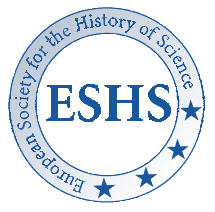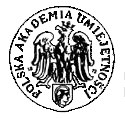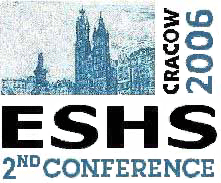Last modification: 25 September 2008
Online Book of Abstracts - A Thematic List:
SESSIONS / SYMPOSIA
Edited by Michal Kokowski
http://www.cyfronet.pl/~n1kokows/home.html
n1kokows@cyf-kr.edu.pl
Symposium R-7.
SCIENTIFIC CONNECTIONS BETWEEN AUSTRIA AND POLAND
(AND THEIR GLOBAL IMPORTANCE)
ORGANIZER AND CHAIRMAN OF THE SYMPOSIUM:
W. Gerhard POHL (Linz, Austria)
g.pohl@aon.at
R-7.
Smoluchowski and Vienna
Hermann HUNGER (Vienna, Austria)
hermann.hunger@univie.ac.at
This paper describes the environment in Vienna where Smoluchowski grew up, studied and began his academic career. It will deal with some of the persons who were close to him and influenced his life, both among his family and among his colleagues. I shall describe unpublished records concerning the attempt by his physicist colleagues in Vienna to have him invited as professor to the university which was unfortunately thwarted by inner-university politics. I do not discuss his scientific successes, but concentrate on his other capabilities and interests: in painting, mountain climbing, and music.
R-7.
From Galicia to Vienna: scientific careers of I. Puluj and I. Horbaczewski
Roman PLYATSKO (Lviv, Ukraine)
plyatsko@lms.lviv.ua
Ivan PULUJ (1845, Ternopil region, Ukraine-1918, Prague) graduated from Theological (1869) and Philosophical (1872) Faculties of Vienna University; 1872/74 worked at the Laboratory of Prof. von Lang of Vienna University; 1875/76 at Strasbourg University; 1876/83 at Vienna University; 1884/1916 Professor of "Deutsche Technische Hochschule in Prague" (1888/89 Rector, 1890/91 Dean); in 1910 titled "Hofberaters"; Honorary Member of the Society for Electrical Engeneering in Vienna (1913); proposition to head the Ministry of Education of Austria (1916). He worked on the molecular physics, the cathode and X-rays, electrical engineering. His papers were published by the Physical Society in London in the series "Physical Memoirs (selected and translated from foreign sources)", 1889. Puluj was the first who discovered the ionizing action of X-rays and gave the correct explanation of their origin. The cathode tube of the Puluj's construction (1882) produced the most intensive flow of X-rays (just this tube was used for getting the first X-ray picture in the USA, 1896). Puluj is an author of many inventions and projects for electric power stations in Czechia. Puluj translated and published (1880) "New Testament" in the contemorary Ukrainian and the complete text of the "Bible" (1903).
Ivan Horbaczewski (1854, Ternopil region, Ukraine-1942, Prague) graduated from Vienna University, PhD degree (1877); 1877/83 at Institute for Medical Chemistry of Vienna University; 1st synthesized the urinic acid (1882); 1883/1917 Professor Chech University in Prague (1902/03 Rector); "Hofberaters" (1908); 1917/18 1st Minister of Health of Austria.
In 1899, I. Puluj and I. Horbaczewski was elected as real Members of the Shevchenko Scientific Society. This Society was founded in Lviv, 1873 and from 1892 was functioned as the Ukrainian Academy of Sciences. M. Plank, A.Einstein were foreign real Member of this Society.
R-7.
100 years theory of Brownian motion:
Einstein, Smoluchowski, their forerunners and followers
W. Gerhard POHL (Linz, Austria)
g.pohl@aon.at
The first experimental evidence for the real existence of molecules was a phenomenon called "Brownian motion" described in 1827 by the Scottish botanist Robert Brown. Physicists were fascinated by this observation, that very small particles suspended in a liquid show irregular movements when observed with a microscope. This movements did continue indefinitely without supply of energy to the system. Several qualitative explanations of this phenomenon were put forward in the 19th century. Among them were G. Gouy and Felix Exner. Exner an Austrian physicist made quantitative measurements of the temperature dependance of Brownian motion around 1900. The first quantitative theory was published by Albert Einstein in 1905. Marian von Smoluchowski, at that time professor at the University of Lviv (Lemberg), developed a theory of Brownian motion from different points of view in 1906, arriving at the same conclusions as Einstein. Smoluchowskis reasoning had been influenced by his experiences at the University of Vienna and the kinetic theory of his teacher Ludwig Boltzmann. Smoluchowski was a member of the Polish Academy of Arts and Sciences in Cracow. In 1908 Jean Perrin published experimental results supporting the Einstein-Smoluchowski theory. He used emulsions to measure sedimentation and diffusion of small spherical particles of known diameter. From these data he calculated Avogadro´s number and the diameter of molecules.
The theoretical work of Einstein and Smoluchowski will be compared with the experimental results of their forerunners and followers.
R-7.
Michael Sendivogius:
an alchemist and Austrian-Polish double agent of the beginning 17th Century
Rudolf W. SOUKUP (Vienna, Austria)
rudolf.werner@kabelnet.at
Michael Sendivogius was born as Michał Sedzimir on 2nd of February 1566 in Luokwica near Sacz in Poland. At first he studied in Cracow, later on at the Universities of Leipzig and Vienna. In 1593 he stayed in Prague where he became a courtier for the Emperor Rudolf II.
In 1604 he published his well know "Novum Lumen Chymicum". The 12th treatise of this book emphasizes that heat is nothing else than movement. It is motion that causes water to rise from a hot cucurbite into a cold alembik. In the epilog we find quite a most interesting passage: The philosophical saltpetre is necessary for all organisms, he is "the secret nutriment of life". Present as an invisible spirit this saltpetre is - so to speak - "consealed" in the air. When Sendivogius tells us that also man is fed by air, because air is the hidden food of life, one has the impression that this alchemist has discovered oxygen. (Oxygen endeed is produced when saltpetre is heated up.) There is evidence that Sendivogius knew something about the importance of air as prerequisite of fire stemming from his publication of 1607 Dialogus Mercurii, Alchymistae Et Naturae. There he wrote "... vita vero ignis aer est, sine aere ignis extinguitur ...": The real life of fire is air, without air fire extinguishes.
Between 1619 and 1624 Sendivogius either stayed in Vienna at the court of Ferdinand II. or in Cracow. He promised to the Hapsburg Emperor to supervise a new lead mine in Silesia. At the same time his was secretary of the Polish King Zygmunt III. Sendivogius was strongly influenced by the Polish Crown Marshall Mikołaj Wolski, who was not only interested in politics and occult sciences but also in the steel industry.




